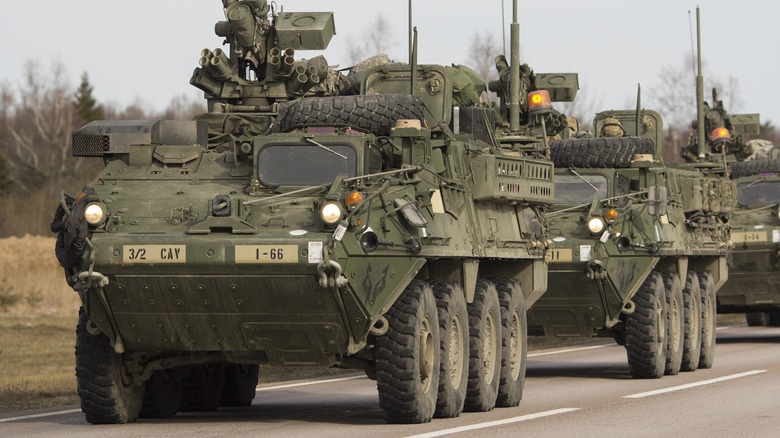Here's How The Army Is Trying To Adapt Hybrid Technology
With hybrids and electric vehicles dominating the consumer market, it was only a matter of time before other industries began capitalizing on the shift to more fuel-efficient modes of transportation. And with some people still preferring hybrids over EVs, the U.S. Army has set its sights on adding some to its arsenal.
According to an active Request for Information file, the military wants to bring hybrid technology into its eight-wheeled Stryker vehicles. The heavily armored infantry fighter has been a go-to for the U.S. since 2002 and even received an engine upgrade in 2020. However, with the RFI, the Rapid Capabilities and Critical Technologies Office (RCCTO) made it public that it's interested in adapting the vehicle with the latest automotive technology, giving it a hybrid engine.
However, don't expect a hybrid Stryker in the field soon. Currently, the RCCTO is only "seeking sources and information" on the subject, hoping to better understand the validity of such a shift. How much would it cost? What infrastructure would be needed to support the hybrid vehicles? These questions and many more are a priority for the department before any decision is final, but it certainly seems like hybrids are on the way for the U.S. Army.
Why is the Army interested in hybrids?
While it could be some time before hybrid military vehicles hit the market, it's no surprise the military would be interested in investing in the new engines. Hybrids bring many benefits to any vehicle, regardless of their purpose, and the Request for Information outlined precisely what the military is looking for in the potential new Stryker.
First and foremost, and most obvious, is fuel efficiency. Hybrids consume less fuel because they have mixed electric and gasoline-powered engines. Strykers undoubtedly require a lot of gas, so double dipping in an electric engine would help. However, the RCCTO aims to increase all-around automotive performance, including acceleration, top speed, power storage, and generation. Naturally, these improvements must come without sacrificing the tank's crew space.
The U.S. Army also wants to fully utilize the massive battery that a hybrid Stryker would require. Fuel efficiency aside, the goal is for the vehicle to act as a generator, supplying power to other systems where necessary. Another benefit of switching to hybrids is their quietness compared to traditional combustion engines. Naturally, the Army wouldn't turn down additional stealth capabilities. The hope is that the hybrid could "conduct battery only silent watch and silent mobility beyond non-hybrid baseline performance specifications." If the hybrid Stryker comes to fruition, it'll add another impressive vehicle to the arsenal, joining the M10 Booker in turning heads.

